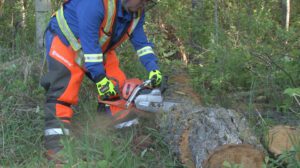Chainsaw Safety Training: Essential Guidelines According to OSHA
Chainsaws are powerful tools used in various industries, including forestry, construction, and landscaping. However, they are also incredibly dangerous if not used properly. The Occupational Safety and Health Administration (OSHA) recognizes the hazards associated with chainsaw use and has established guidelines to ensure worker safety. Proper chainsaw safety training osha, in line with OSHA standards, is crucial for anyone who operates this equipment. This article explores the key components of chainsaw safety training as mandated by OSHA, emphasizing the importance of following these guidelines to prevent accidents and injuries.
The Importance of Chainsaw Safety Training
Chainsaws can cause severe injuries or even fatalities if mishandled. The high-speed chain, capable of cutting through wood, can just as easily inflict serious harm on a human body. OSHA's regulations are designed to minimize the risks associated with chainsaw operation. Through comprehensive safety training, workers learn to recognize potential hazards, understand the functionality of the equipment, and implement safe work practices. This training is not only essential for the safety of the individual operator but also for the protection of coworkers and bystanders.
Key Elements of OSHA-Approved Chainsaw Safety Training
Understanding OSHA Standards: Chainsaw operators must be familiar with OSHA’s specific standards, particularly those found in OSHA’s logging operations regulations (29 CFR 1910.266). These regulations outline the necessary safety procedures and protective equipment required for chainsaw use. Training programs should cover these standards in detail, ensuring that workers are aware of their legal obligations and the best practices for safe operation.
Personal Protective Equipment (PPE): One of the most critical aspects of chainsaw safety training is the use of personal protective equipment. OSHA mandates that operators wear appropriate PPE, including hard hats, safety glasses, hearing protection, gloves, and chainsaw-resistant chaps or pants. These protective items are designed to minimize the risk of injury in the event of an accident. Training should emphasize the importance of consistently wearing PPE and ensuring that it is in good condition.
Chainsaw Maintenance and Inspection: Proper maintenance and regular inspection of chainsaws are vital to safe operation. OSHA guidelines require that chainsaws be inspected before each use to ensure they are in safe working condition. Training should teach operators how to check for common issues such as dull blades, loose chains, and fuel leaks. Operators should also learn the correct procedures for maintaining chainsaws, including sharpening blades, tightening chains, and cleaning the air filter.
Safe Operating Techniques: Safe operating techniques are at the core of chainsaw certification online. OSHA standards emphasize the importance of maintaining a secure footing, using both hands to operate the chainsaw, and never cutting above shoulder height. Training programs should also cover techniques for safely starting the chainsaw, proper body positioning, and the importance of staying alert to potential hazards like falling branches or shifting logs.
Emergency Procedures: Despite all precautions, accidents can still happen. OSHA requires that workers be trained in emergency procedures, including first aid and how to respond to chainsaw-related injuries. Workers should know how to stop the chainsaw quickly, call for emergency assistance, and provide initial care for injuries. Training should also include information on how to handle situations where the chainsaw becomes jammed or otherwise compromised.
Investigate our site for more information.
Online Aerial Platform Operator Course

Comments
Post a Comment